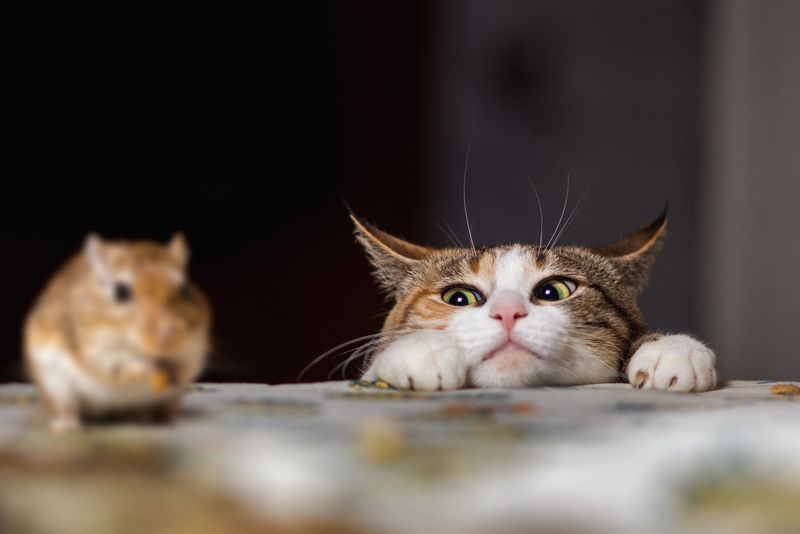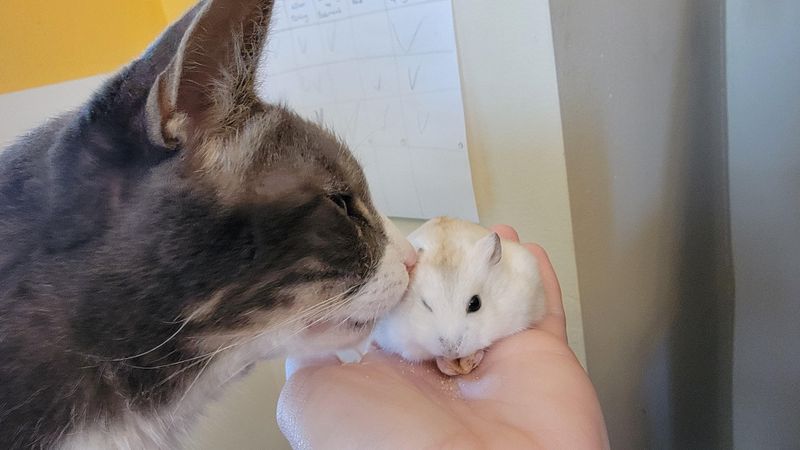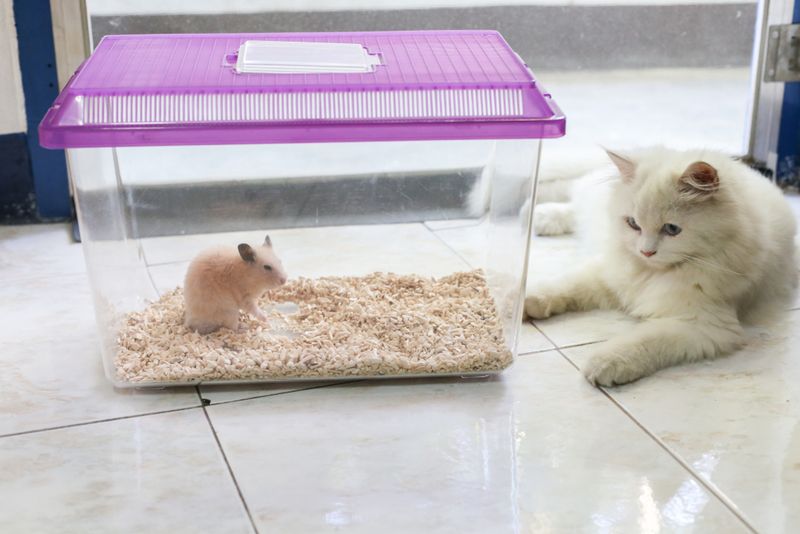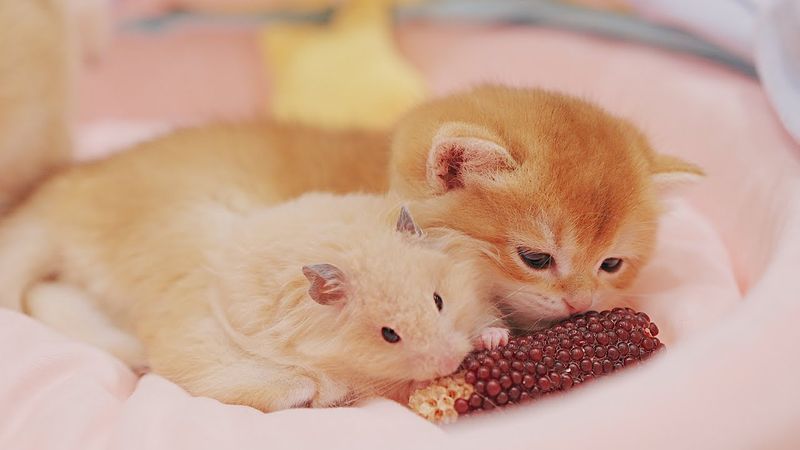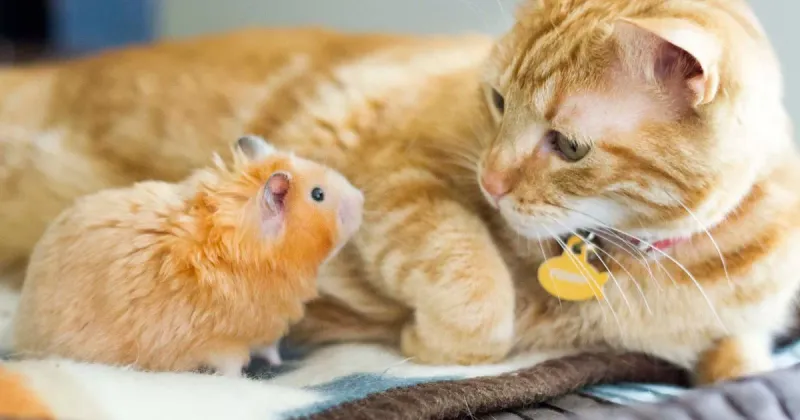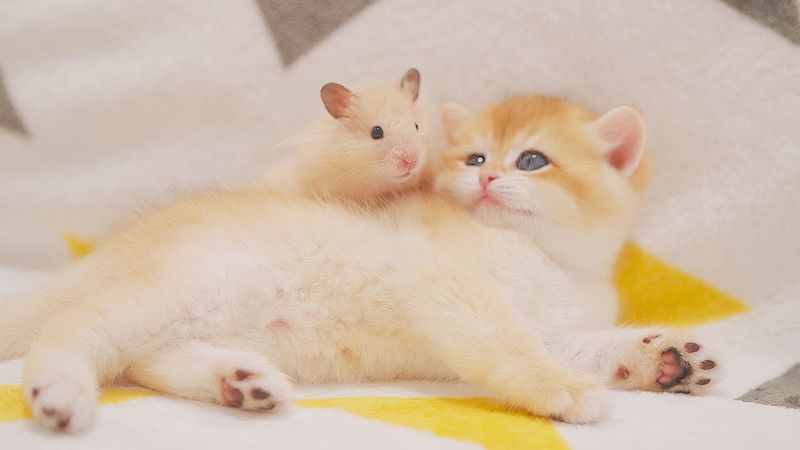📖 Table of Content:
- 1. Natural Instincts Are Hard to Overcome
- 2. Supervised Interactions Are Essential
- 3. Proper Housing Makes All the Difference
- 4. Scent Familiarization Can Reduce Hunting Behavior
- 5. Age and Personality Matter Significantly
- 6. Training Can Modify But Not Eliminate Behavior
- 7. True Friendship Remains Extremely Rare
Cats and hamsters come from very different corners of the animal kingdom. One is a natural hunter, the other a small, vulnerable rodent. This contrast makes their potential relationship complex and often misunderstood.
While they may live in the same household, their instincts don’t easily align. A cat’s curiosity and prey drive can unintentionally put a hamster in danger. Understanding these instincts is key to ensuring safety for both animals.
Careful planning and strict boundaries are essential when these pets share a home. Housing, supervision, and interaction must be thoughtfully managed. Only then can peaceful coexistence become a cautious possibility.
1. Natural Instincts Are Hard to Overcome
Cats possess strong hunting instincts that have evolved over thousands of years. When they see small, quick-moving creatures like hamsters, their predatory drive often kicks in automatically.
Even the sweetest, most domesticated cats might view hamsters as prey rather than potential friends. This instinctual response isn’t something cats can easily control or that owners can train away completely.
The size difference between these animals creates an inherent power imbalance that makes true friendship unlikely. A hamster will typically view a cat as a threatening predator, causing stress that can impact its health and well-being.
2. Supervised Interactions Are Essential
Never leave cats and hamsters alone together without your direct supervision. The consequences could be fatal for your small pet.
During any interaction, keep the hamster in a secure enclosure that the cat cannot access. Glass tanks work better than wire cages since cats can’t reach through them with their paws.
Observe your cat’s body language during these supervised meetings. Dilated pupils, twitching tail, and intense staring are warning signs that your cat views the hamster as prey. End the interaction immediately if you notice these behaviors to prevent stress for both animals.
3. Proper Housing Makes All the Difference
Secure housing for your hamster provides the foundation for any peaceful coexistence. The enclosure should be escape-proof and inaccessible to curious paws.
Glass aquariums with secure mesh tops work best, as they prevent both hamster escapes and cat intrusions. Place the habitat in a room that can be closed off from cats when you’re not around to supervise.
Keep hamster habitats elevated on sturdy furniture where cats can’t easily jump or knock them over. Some pet owners install special shelving units designed specifically for small pet enclosures that keep them safely out of reach while still visible.
4. Scent Familiarization Can Reduce Hunting Behavior
Gradual scent introduction helps cats become desensitized to hamsters. Try swapping bedding materials between pets to familiarize them with each other’s smells without direct contact.
A cloth rubbed gently on your hamster (under supervision) can be placed near your cat’s sleeping area. This exposure helps reduce the novelty factor that might trigger hunting instincts.
Some pet owners report success using synthetic pheromone products designed to calm cats. These products, available as diffusers or sprays, may help reduce predatory behaviors when used consistently in areas where both pets spend time.
5. Age and Personality Matter Significantly
Kittens raised around small pets sometimes develop less intense hunting behaviors toward them. Starting young can help, though instincts remain unpredictable.
Senior cats often show less interest in hunting and may be more likely to ignore hamsters entirely. Their reduced energy and blunted predatory drive can make coexistence easier.
Individual personality plays a crucial role, too. Some cats naturally have lower prey drives or show curiosity without aggression. Observe your cat’s reactions to wildlife, toys, and TV animals for clues about how they might respond to a hamster before bringing one home.
6. Training Can Modify But Not Eliminate Behavior
Clicker training rewards cats for calm behavior around hamster enclosures. When your cat sits quietly near the habitat without showing hunting behaviors, click and treat immediately.
Consistent negative associations help too. A spray bottle of water used when cats show predatory interest teaches them that hunting behaviors lead to unpleasant consequences.
Provide plenty of alternative outlets for hunting instincts through interactive toys, feather wands, and puzzle feeders. A mentally and physically stimulated cat is less likely to fixate on your hamster as a potential prey item.
7. True Friendship Remains Extremely Rare
Despite viral videos showing cats and hamsters appearing to be friends, these cases represent extraordinary exceptions, not the rule. Most animal behaviorists caution against expecting or forcing such relationships.
What looks like friendship to humans may actually be tolerance or indifference from the cat’s perspective. The hamster, meanwhile, might be experiencing stress even when appearing calm.
Responsible pet ownership means accepting the natural limitations of cross-species relationships. Rather than pursuing an unlikely friendship, focus on creating a home environment where both animals can live safely and comfortably with appropriate boundaries.

